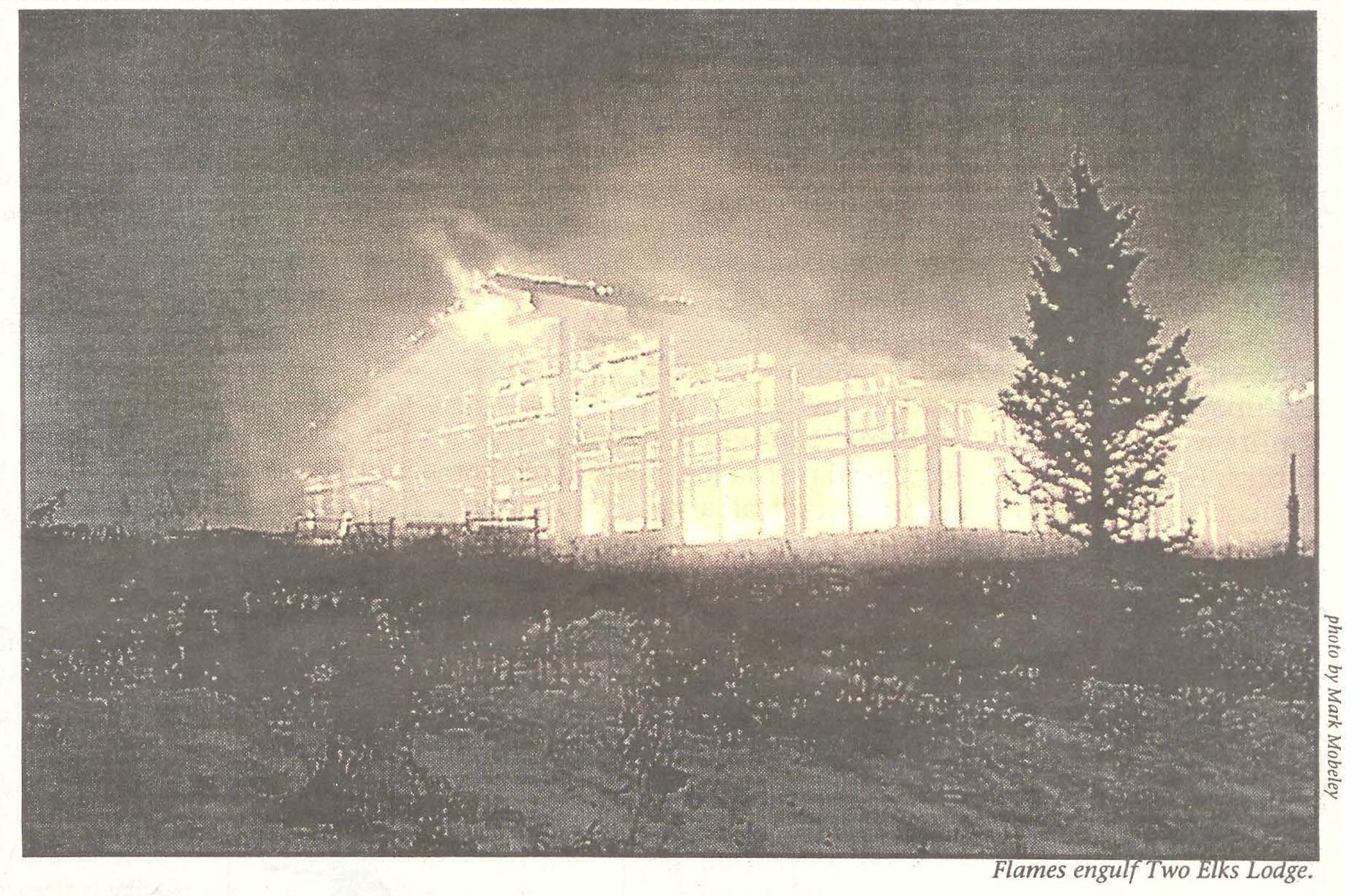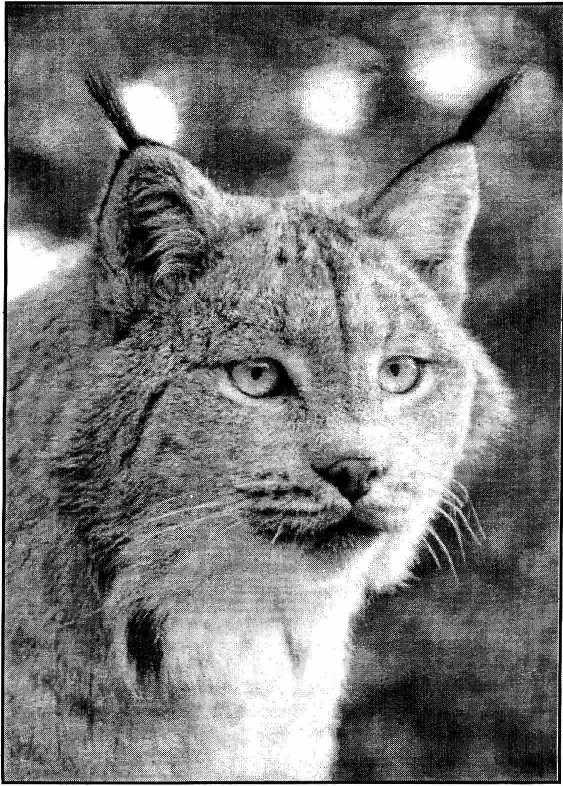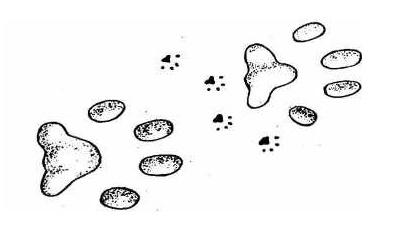Lacey Phillabaum
ELF Burns Down Vail Resort

During the night of October 18, cloaked in the dark of an almost new moon, two or more people crept along a Colorado ridgeline, leaving plastic milk jugs filled with gasoline as fiery calling cards at five buildings and four chairlifts. The 33,000- square-foot, 550-seatTwo Elks Lodge was totaled, resulting in minimum damages of $12 million to Vail Asso- dates (VA). In addition, a 2,500- square-foot picnic shelter, a ski patrol building and one of the chair lifts were ruined, pushing the total amount of damages much higher than the widely-reported $12 million and making this the single most expensive act of environmental sabotage in US history.
The only known witnesses to the fire were four sleeping hunters, who alerted the authorities after they were awakened by the blazes around 4 a.m. One of the four, Neil Sebso, had gone to sleep around midnight seeking warmth inside a Vail restroom, while the other three camped outside. Sebso says he woke from a sleepy fog, thinking that somebody had opened the door, looked in and left.
When he got up to investigate, he saw nothing "and went back to bed. Next thing, I was awoken by Steve," who showed him the rising flames.
The arson fires were set only five days after a court had ruled that Vail resorts could proceed with its planned Category III expansion into the Two Elk Roadless Area, despite the objections of local environmentalists.
The Colorado-based group Ancient Forest Rescue (AFR) has led that opposition, noting that the development of 2,200 acres of additional skiable terrain on public land is but a prelude to VA's real plans for building luxury condominiums, a new base area and village to village gondolas on as much as 3,000 additional acres.
The new ski area alone, without the condos, would include four new chair lifts, 12 miles of road and ski ways and a 350-seat restaurant spanning Two Elk Creek, among other things. Ben Doon of AFR noted in the May-June issue of the Earth First! Journal that, "Twelvehundred logging trucks would be needed to haul away six million board feet of virgin spruce and fir. In return for the destruction of this pristine roadless area, the public would get back a pitiful 1.5 cents on every dollar made by Vail Inc. on this expansion, or less than $1 for every $56 lift ticket." Vail's net revenues last year were $291 million, garnered from Vail Mountain and its five other ski resorts, which already include six hotels, 72 restaurants, 40 retail and rental outlets and over 1,300 condominiums. Altogether, Vail Resorts, the parent company of Vail Associates, controls almost half of the Colorado ski market.
The focus of the environmental opposition, however, was not the unwieldy size of the corporation but the unconscionable destruction of the last of the potential lynx habitat in Colorado. Since 1935, only four lynx sightings have been documented in Colorado, and three of those sightings were in the immediate vicinity of the proposed expansion. White River National Forest Supervisor Martha Ketelle had agreed in writing not to allow work on the expansion until a voluntary consultation with the US Fish and Wildlife Service (USFWS) on the risk to the lynx had been concluded. But both Vail Resorts and the Forest Service threw the pretense of concern about the lynx to the wind when logging equipment was brought in on October 16.
Why the rush? Because hearings are now being conducted on listing the lynx as endangered. If the lynx is so listed, USFWS consultation would be required, and, as the Colorado Division of Wildlife has stated, "If there is any critical lynx habitat in the state, this is it!" Indeed, the listing of the lynx would necessitate the largest endangered species recovery effort ever, encompassing 53 national forests and 24 Bureau of Land Management districts.
And so, as soon as the 10th Circuit Court of Appeals decided on October 14 not to impose an injunction on the expansion until the appeal is heard, Vail began clearcutting and roadbuilding. AFR intended to protest in earnest. But while AFR bided its time, the ELF acted.
The widely held suspicion that the fires were set to protest the Vail expansion was confirmed two days after the fire when the ELF issued a communique claiming responsibility (see box opposite page).
Suddenly, the ELF was center stage in the theater of national media. But the star of the show is camera shy. The ELF is an underground group with no spokespeople or office. In the past two years, its actions have included burning two Forest Service wildlife research facilities in Washington burning Forest Service vehicles and spiking trees in Oregon's Willamette National Forest, monkeywrenching bulldozers in California, and burning a horse slaughterhouse in central Oregon.
Much of the information about the ELF available in the US has come from the EF!J. In the September-October 1993 issue, an anonymous article announced the creation of the ELF in England. It said the ELF "is a movement of independently operating eco-saboteurs" that split from the "British EF! movement, which has focused largely on public direct actions." The author noted that, unlike the ALF which seeks publicity, "ELF cells, for security reasons, work without informing the press and do not claim responsibility for actions... The surest way to be done for conspiracy or to attract surveillance or infiltrators is to seek attention." Instead, the ELF publicizes pre-announced, internationally coordinated "Earth Nights." These announcements always call for harm to property only, never life.
A second article in the September-October 1996 EF!J by Tara the Sea ELF specified that the "ELF solidified in 1992 at the first UK Earth First! gathering in Brighton, England." It also reiterated that the "ELF has no command structure or solid network, each group is independent. There is no press office or office, so the authorities have nowhere to tracee or focus their eyes and ars."
The ELF also lacks a phone number, contact person or e-mail address. For information, the journalists covering the Vail arson turned to the next best things, Earth First! and the Animal Liberation Front press office in Minnesota (what the heck, EF!, ALF, ELF, the names are so similar!). The story quickly turned from arson and its motives, to "ecoterrorism" and its perpetrators. Much like when Theodore Kaczynski was arrested and the media tried to portray him as an Earth First!er, the spark of interest was whipped into a full-blown conflagration by long-time anti-environmentalists, Ron Arnold and Barry Clausen. They put themselves forward as experts on "eco-terrorism," and contacted major media outlets to spin the story. Lazy reporters failed to disclose both Arnold and Clausen's ties to the timber industry. In the past, Arnold has gone as far as to say, "We are out to kill the fuckers. We're simply trying to eliminate them. Our goal is to destroy environmentalism once and for all." In service of that agenda, Clausen and Arnold portray all frontline activists as violent terrorists, besmirching the good names of thousands of activists across the country who put their own lives on the line as Earth First

The Rocky Mountain News ran with the story, quoting Clausen saying, "The Earth First! Journal puts out the call for action. They read the literature and then they go out and commit acts of sabotage." To prove his credibility as an eco-terrorist researcher, Clausen contrives analysis like, "The language in the Internet communique claiming responsibility 'sounded exactly like' other messages the Earth Liberation Front has sent," specifically because the communique uses the word "tolerated" (that most terrorist of words!). Clausen continues, "The ecoterrorism movement has spawned 'serial arsonists, no telling how many, who are going around the West.'" Ron Arnold even said in USA Today that "the fires have 'upped the ante' to the tactics used by terrorists in Europe and the Middle East." While Clausen and | Arnold spewing bull-pucky a is no new thing, the media's alarming perpetuation of libelous and inaccurate information was truly | surprising. Perhaps no article was further from the truth than one in the Lona don Observer, which claimed, S "Last month's issue of Live Wild or Die delivered an ecoterrorist manifesto that has come to a smoking climax in the ski town of Vail, Colorado." The ELF "is lead by a man in his early thirties who calls himself 'Voice from the Siskiyous'... In 1988 Earth First! fell apart.
Foreman, concerned at the growing violence, ceded the leadership to Darryl Cherney and Judy Bari... The group is now part of the Direct Action Movement, based in Eugene, Oregon, and publishes a Direct Action Manual... The ELF is now part of a network loosely fronted by an alliance called the Liberation Collective, based in Portland, Oregon." That one article contains so many inaccuracies it takes the whole idea of slovenly journalism to a new level. For the record, Live Wild or Die did not print an "eco-terrorist manifesto," it doesn't publish monthly, there is no ELF leader, EF! didn't fall apart, there is no EF! leader, Judy is spelled Judi, there is no such thing as the Direct Action Movement, and the Liberation Collective is not an ELF front.
Despite the media's seeming certainty about the identity of arsonists, some have questioned the authenticity of the ELF communique. They point out that the communique wasn't sent out until two days after the arson, that the ELF has said previously it wouldn't claim responsibility for actions and that the communique seems to contain a veiled threat of physical violence ("Foryour safety..."). Likewise, one AFR activist pointed out that a more effective act of sabotage would have been aimed at the machinery working on the expansion, not the existing resort.
Oh yes, Ancient Forest Rescue... The environmentalists working publicly to stop the Vail expansion, has been somewhat lost in the sound and fury over who or what the ELF is. Their nonviolence code specifically disavows property destruction, and AFR spokesperson Jeff Berman went so far as to say, "J would rather see Vail Resorts, through all their duplicity and greed, destroy the Two Elk Roadless Area than have some cowardly actions and threats erode the growing opposition to Vail's rapacious plans..."
Such sentiments were reiterated by mainstream environmentalists and even some Earth Firstlers across the country, who called yet again for a reconsideration or prohibition of monkeywrenching in the radical environmental movement. Meanwhile, other activists maintained the ELF's actions should be supported by Earth First!
Over the years, a number of arguments have been trotted out to justify night actions. Some people believe sabotage discourages developers by hitting them in the pocket book, making insurance companies leery of underwriting their development schemes. Some say strategic wrenching during certain windows of opportunity can delay a project until other tactics permanently halt it. Some go in for the pure intimidation value or the visceral pleasure, offering a shining light to the disaffected masses by highlighting the true power of a turn of the wrench or a flick of the Bic. Opponents argue primarily that sabotage alienates too many people whose support is critical to the development of a mass movement and that sabotage doesn't really stop development anyway. Regardless of their stance, however, both camps tend to cling dogmatically to their own perspectives, with opponents back-pedaling and advocates spinning faster than the facts come in.
Truth be told, it is unlikely that a complete diagnosis of the damage inflicted to Vail Associates will ever be revealed. VA has gone to great lengths to lull the skiing public into believing that "the premiere guest experience for which Vail has always been known will not be compromised." Its list of "frequently asked questions" provides reassurances about every last detail: "Will the dining experience on Vail Mountain be negatively impacted by the fires?" Don't worry, "Vail Mountain has 17 other restaurants."
On behalf of the lynx,
five buildings and four ski lifts at Vail were reduced to ashes on the night of Sunday, October 18. Vail, Inc. is already the largest ski operation in North America and now wants to expand even further. The 12 miles of roads and 885 acres of clearcuts will ruin the last, best lynx habitat in the state. Putting profits ahead of Colorado's wildlife will not be tolerated. This action is just a warning. We will be back if this greedy corporation continues to trespass into wild and unroaded areas. For your safety and convenience, we strongly advice skiers to choose other destinations until Vail cancels its inexcusable plans for expansion.
—Earth Liberation Front
Certainly, from a public relations standpoint, it's prudent for VA to underplay the loss, but most of the evidence corroborates the claim that the direct economic damage was minimal. The cost of the torched buildings will be covered by insurance, as will any "business interruption" revenue losses. Vail Associates says media coverage of the fires has not affected bookings for the coming season, and its stock price was up 1.5 points as of close of trading the day after the fire. The resort did open a few days later than planned, but that was attributed to an extreme winter storm, not the arson.
Strategically, the arson seems to have had little on-the-ground effect as well. Vail was able to continue logging in the roadless area two days after the arson. At present, work in the roadless area has been stopped due to early snows.
The indirect effects of the arson are harder to quantify. It certainly gained the anti-expansion campaign an international audience. At some level, the elves' action will cause developers to think twice about undertaking such a controversial expansion in the future, and it's possible that insuring such schemes will be more difficult. In the whaling industry, for example, concerted sabotage has made it almost impossible for prospective whalers to insure their boats.
Perhaps the most dramatic effect of the arson will not be felt by VA at all, but by the activist community. In a state where skiing is king, AFR had succeeded in the impossible—wrenching local sentiment away from VA. Of 401 comments received by the Forest Service in regards to the expansion, 375 (over 93 percent) opposed the project, while only six expressed support. Of those six, four were from VA executives and contractors.
After the fires, the pendulum swung back again. Two hundred community do-gooders offered VA volunteer help. "Offers of support poured in from area businesses, school children and residents, " according to the Associ ated Press. "These fires have created a lot of sympathy for Vail Associates," said Town Manager Bob McLaurin, "I thinkit's goingto pull this community together."
The fires also prevented AFR from continuing their protest of the expansion. Many people have surmised that AFR had "failed" to stop the expansion and that sabotage was the next logical step. In truth, AFR had already established satellite camps in the roadless area in order to protest and monitor the expansion. Their plan to begin direct action when Vail attempted to bring in a bridge to cross Eagle Creek, as well as monitoring to watch for contract violations, was suspended due to the extreme law enforcement presence immediately following the fires. (There were five National Guard helicopters scouring the region.)
In the aftermath of the arson, an intense police investigation has been focused on the activists. From day one, law enforcement threw itself willy- nilly into the search, tossing a dragnet over all of the local activists. One hundred and eighty-five public safety officers and Vail employees scoured the mountain the day of the fire. Since then, up to 45 Bureau of Alcohol, Tobacco and Firearms agents, 18 FBI agents and 25 Eagle County Sheriff officers have been working on the investigation. Over 50 interviews have been conducted, including many with local environmentalists. Stephanie Altman, head of the Wilderness Study Group at Colorado University in Boulder, was contacted by FBI agents, and when she failed to return their phone calls, they went to her advisor, drilling him about why she wouldn't talk to investigators. Another university student, whose only involvement in the campaign was attending a single slide show, was also questioned. Jonathan Staufer, lifelong Vail resident and AFR activist, and other AFR activists were contacted. Fortunately, most environmentalists close to the campaign have refused to speak to investigators, and only random people at the edge of the campaign have dignified the witch-hunt with the universal: "But, I don't know anything!" In the final analysis, there is no way to know whether the arson was more effective than the civil disobedience it preempted. In the past, sabotage has helped stop developments in Colorado. At Bowen Gulch, a timber sale on the edge of Rocky Mountain National Park, tree spiking was part of a campaign of road blockading, tree sitting and boycotting that delayed the sale until it was incorporated into the 1989 Colorado Wilderness bill. Alternatively, the East Fork ski resort in Colorado was stopped without any sabotage. What is important is that the activists who have been there for the long haul continue to oppose the expansion. And if the international magnifying glass focused on Vail helps stop the expansion, it might all have been worth it.

